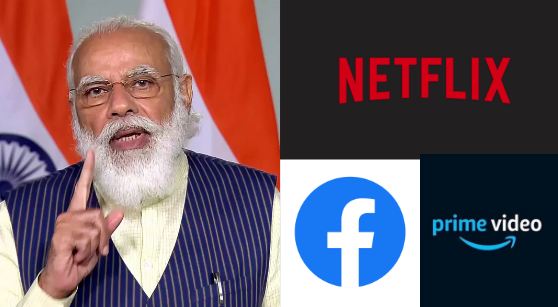After an unending wait, India is finally about to tame OTT platforms and what the government is calling “intermediaries and online curated content companies”. With the release of anti-Hindu web series Tandav, and many like it in the past, a near-unanimous call was raised in India to regulate OTT platforms and digital media companies from publishing just about any content they deem fit. Now, according to a report by the Hindustan Times, the Modi government has framed rules which will mandate such platforms to exercise “due caution and discretion” while airing content that may impact India’s sovereignty and integrity, threaten or jeopardise the state’s security and be detrimental to the country’s foreign relations.
Interestingly, not just OTT platforms, but social media companies like Facebook too would have to adhere to the new set of rules. According to HT, social media companies and streaming service providers will be brought under a three-tier regulatory framework, according to proposed new rules. The government is also deliberating extending existing legislation such as the Cable Table Television Networks Regulation Act, Press Council Act, and other relevant laws to govern online content. The new rules comprehensively direct OTT platforms and social media companies to:
(i). Classify content for online curated content platforms under a universal rating (U), U/A seven plus, U/A thirteen plus, U/A sixteen plus and Adult, for people over 18. The officials told HT that the classifications will have to be prominently displayed.
(ii). To formulate and enable access control mechanisms, including parental locks, for content for those over 13.
(iii). The content must be classified according to context, theme, tone and impact, and target audience. The government has considered sensitive aspects like drug misuse, violence, paedophilia, sex, racial or communal hatred while framing the said rules. For example, much of the content which is currently accessible to individuals over the age of 16 on OTT platforms, will be classified as ‘Adult’ content according to the new rules, mandating content involving nudity, glamorisation of drug abuse and violence, among other themes, to be made accessible only for adults.
(iv). Additionally, a three-tier regulation system has been proposed to be put in place to ensure that OTT and social media platforms abide by the said rules.
The three-tier system will consist of a self-regulatory mechanism, under which a grievance redressal system will also be set up. The details of the grievance redressal officer must be prominently displayed by the platform. The second tier or the self-regulatory body will be headed by a retired judge of the Supreme Court or High Court. An appeal may be referred to this body if a person believes his or her complaint has not been appropriately addressed. Finally, at the top of this system will be an inter-ministerial committee, which will be empowered with the authority of taking suo moto cognisance of issues, and recommend the blocking of content in contravention of the Code. The committee will have representatives from the ministries of information technology, information and broadcasting, home, law, external affairs, defence, and women and child development.
The proposed Code will most definitely help in better filtration of content, while also making online content producers and OTT platforms think multiple times before publishing anti-Hindu content.
